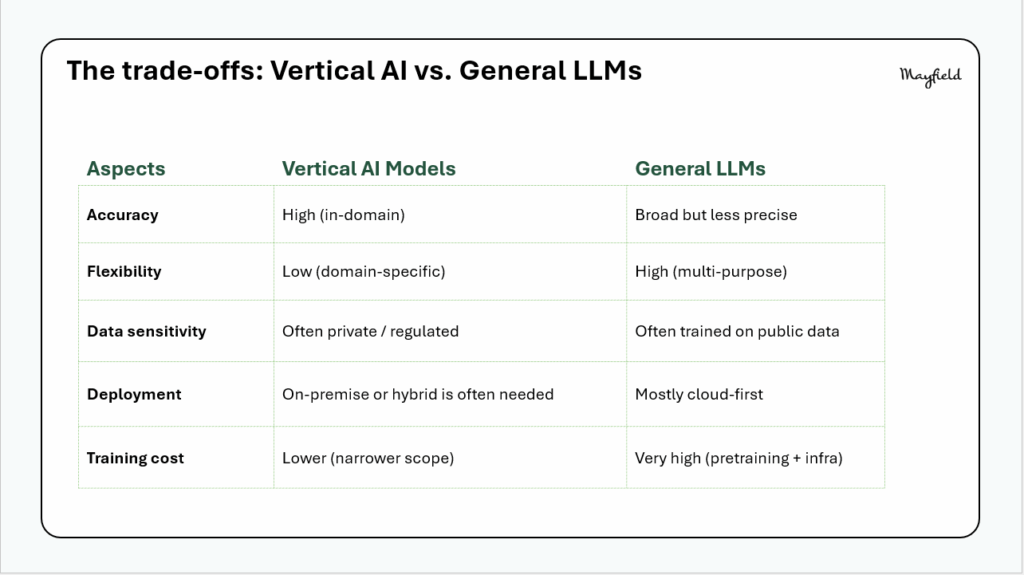


What are vertical AI models? They’re domain-specific models built for particular industries or functions, delivering domain expertise, regulatory compliance, and trustworthy results.
While OpenAI and Anthropic race for general AI supremacy, vertical AI companies will build billion-dollar businesses by focusing on specific industries or functions.
In this blog, I’ll cover:
Vertical AI models are fine-tuned or purpose-built for specific industries or functions. Here are some areas where they’re already making an impact:
Why are these specialized models taking off? It comes down to four key advantages:
1. Accuracy beats generality every time
Vertical AI models offer high domain-specific accuracy but trade off flexibility. General LLMs give you broad capabilities but less precision where it matters. If you’re a doctor diagnosing a rare condition or a lawyer analyzing a complex contract, would you rather have an AI that knows a little about everything or a lot about your exact problem?
Founder takeaway: Don’t try to build a general solution. Pick a specific problem in a single industry where accuracy is mission-critical, and solve it better than anyone else. The narrower your initial focus, the more likely you are to deliver tangible value.
2. Faster time to value (and lower training costs)
Models tailored to industry data (like medical records in healthcare) deliver usable outcomes out-of-the-box with minimal tuning. This means companies can implement vertical AI solutions and see ROI much faster than general models requiring extensive customization.
Founder takeaway: Build with ROI timelines in mind. Your customers need to see value within weeks, not months. Design your product to deliver quick wins with minimal setup, then expand capabilities over time.
3. Reduced hallucination risk means higher trust
Vertical models trained on trusted, structured, and unstructured data dramatically reduce hallucinations. For businesses where accuracy is non-negotiable, this difference isn’t just nice to have—it’s essential.
Founder takeaway: Trust is your moat. Design your model evaluation and QA processes to be as rigorous as your model itself. Having reliability metrics that your customers can understand will differentiate you from general-purpose AI solutions.
4. Better regulatory alignment
If you work in finance, healthcare, or another regulated industry, you know compliance isn’t optional. Vertical AI models are built with explainability, privacy, and auditability in mind—critical factors that general-purpose models often struggle with.
Founder takeaway: Embrace regulation as an opportunity, not an obstacle. Build compliance into your product from day one, and make it a core part of your value proposition. The more regulated the industry, the higher the barriers to entry for your competitors.
1. Open-source vertical models are democratizing access
The rise of open-source specialized models like @Clinical Camel and @FinGPT represents a seismic shift in the AI landscape.
The Clinical Camel model was developed by researchers to provide a healthcare-focused alternative to general-purpose models. It understands medical terminology, recognizes conditions, and generates clinically relevant responses—all without the massive costs of building from scratch.
FinGPT has emerged as a community-driven project tailored specifically for financial applications. It understands financial jargon, processes market data, and generates insights relevant to investment decisions.
The implications are profound:
Founder takeaway: Don’t reinvent the wheel. Start with the best open-source vertical model in your domain and focus your resources on the last mile of customization that creates your unique value. Your differentiation should come from proprietary data and workflow integration, not base model capabilities.
2. Synthetic data is solving the data scarcity problem
One of the biggest challenges for vertical AI has been the scarcity of high-quality, labeled data. This is where synthetic data generation is making a tremendous impact.
Synthetic data techniques are becoming increasingly sophisticated:
Domain adaptation techniques are equally important, allowing knowledge to transfer from one domain to another with minimal additional data:
Founder takeaway: Data strategy is product strategy. Invest in synthetic data pipelines early, especially if you’re targeting industries with strict privacy regulations. A synthetic data advantage can give you months or years of lead time over competitors stuck waiting for real-world data collection.
3. Proprietary data is the new competitive moat
Perhaps the most transformative trend is how organizations are leveraging their internal data to create unique AI capabilities.
This trend is manifesting in several ways:
The value isn’t in the base model anymore—it’s in how effectively it’s specialized with proprietary data. Companies like Anthropic and OpenAI are increasingly positioning themselves as providers of adaptable foundation models.
Founder takeaway: Design your product to get better with each customer. Create virtuous data loops where customer usage improves your models, and make data rights central to your solution. The winner in each vertical will be the company with the most comprehensive proprietary data assets.

Founder takeaway: Embrace the constraints of vertical AI. Your deployment model, pricing strategy, and technical architecture should align with industry realities. If your customers need on-premise solutions for regulatory reasons, build that capability from day one instead of forcing a cloud-only approach.
Enterprise AI adoption is accelerating, but here’s the crucial insight: fine-tuning on proprietary enterprise data is becoming the new competitive moat. Vertical AI models—those specialized for specific domains—are where the real enterprise value lives. The future isn’t either/or—it’s a hybrid ecosystem where general LLMs provide the foundation, enhanced by vertical adaptations for specific domains.
Founder takeaway: The vertical AI opportunity is still in its early innings. The most successful founders will be those who deeply understand both the industry they’re targeting and the unique capabilities AI brings to that space. Don’t build a one-size-fits-all AI company—build an industry-specific company that leverages AI as its core technology advantage.
